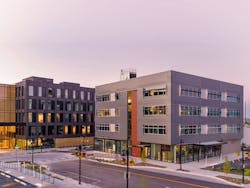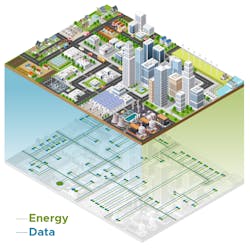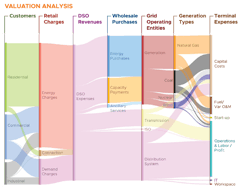After the start of a historic heatwave in August 2020, Californians reduced electric load by 10%. The California Independent System Operator (CAISO) asked customers to take steps like “pre-cooling” buildings and raising thermostats during peak demand. The reduction helped avoid further rolling blackouts.
CAISO’s example showed that demand flexibility can contribute to grid operation. But it also relied on manual, uncompensated actions of customers. For grid operators and customers to get the full benefit of flexible demand, a solution needs to be automated and work for everyday grid operation, not just emergencies.
One promising approach is transactive energy. Transactive energy uses value signals (for example, a dynamic price for electricity) to coordinate flexible loads like smart HVAC systems with other distributed energy resources (DERs), potentially at a massive scale. Several small transactive energy systems are already operating. A new study from the Department of Energy’s Pacific Northwest National Laboratory assesses how a transactive energy system will perform when deployed across an entire region.
The Need
Extreme and widespread winter freezes and summer heat waves are increasing demand for electricity and constraining supply beyond historical levels. National decarbonization goals are driving the electrification of loads in the transportation, building, and industrial sectors. These trends will require unprecedented levels of investment in generation, transmission, and distribution capacity. However, some of these investments could be deferred or avoided by coordinating DERs and demand flexibility.
Demand reduction measures have typically been emergency requests for load curtailment. They are often not well coordinated or automated, and often rely on the uncompensated and manual actions of customers who may get tired of the number of requests from a strained grid. There is a need for improved solutions that integrate the coordination of demand flexibility into everyday grid operation, ensures it is automated, put the customer in control of how much or little they participate, and fairly compensate the customer for the level of flexibility they provide to the grid. This need is starting to be addressed with machine-readable time-varying rates, regulatory rulings allowing DERs to participate in markets, and aggregators and other solution providers, making it easier for customers and their assets to provide flexibility.
Spokane’s Smart Eco-District
The growing number of DERs and the need that intermittent renewable generation creates for 24/7/365 flexibility will require improved DER coordination strategies in the future. Transactive energy solutions have been field demonstrated, having been deployed in the Pacific Northwest, California, the United Kingdom, Netherlands, and Australia (to name a few examples). The Department of Energy is funding additional deployments under the Connected Communities initiative, including demonstrating the “five smartest blocks in the world” in Spokane Washington. The Connected Communities effort supports the Department’s Grid Interactive Efficient Building (GEB) roadmap that aims to triple the amount of demand flexibility on the grid by 2030.
Scaling Up
Deployments have shown the ability of existing loads and DERs to interact in a transactive scheme. However, questions remain about how a transactive system would perform when deployed at scale across an entire region. Would it achieve effective control? How much could it reduce variations in load? Would it work for a range of DERs such as batteries, electric vehicles (EVs), and thermostatically controlled loads? Would it have an economic benefit, and if so, how much would different types of customers save on their utility bill? How would this performance change with more renewable generation?
To answer these questions, the Department of Energy’s Office of Electricity enlisted Pacific Northwest National Laboratory to conduct the Distribution System Operator with Transactive (DSO+T) study. This study conducted an integrated large-scale simulation of the grid to answer these questions.
At the heart of this work is a design for a transactive retail marketplace. This retail market could be run by a DSO, utility, or aggregator. It was designed to be integrated with existing day-ahead and real-time competitive wholesale markets.
This approach has several key features. First, it integrates distribution-level constraints into the retail market operation. This ensures that transactive signals coordinate DERs to not only improve the efficiency of the bulk system but also help manage distribution-level constraints such as substation capacity limits. The second key feature is that the operation of a retail market avoids the ISO having to include a multitude of DER bids into its scheduling and dispatch calculations.
The purpose of the transactive design was not to prescribe an approach but to show that a representative transactive design works at scale. Competing approaches will improve on this design. New approaches could also address the distinct needs and characteristics of different regional markets.
The study’s transactive approach performed well in the large-scale simulation. The simulation modeled >60,000 customers, >100,000 DERs, and 40 DSOs in a region the size of the Electric Reliability Council of Texas (ERCOT). The simulation spanned the entire grid, from the dispatch of bulk generators on the transmission system (and the resulting wholesale prices) to the operation of air conditioning units, water heaters, batteries, and EVs in a diverse mix of commercial and residential buildings.
Across the scenarios studied, the coordination of DERs reduced peak loads 9–15% and reduced average daily load swings 20–44%.
The detail of the annual simulation also highlighted important characteristics and trends. As expected, flexible air conditioning was effective at reducing summer peak load, but provided less flexibility during the temperate shoulder seasons when there is less need for climate control. In these times of year batteries were a more effective resource.
The study also assumed that 30% of residential households had an EV with managed charging. While this increased peak load 9% in the business-as-usual case, EVs demonstrated strong flexibility, moving evening load to later in the night. DER characteristics, such as the coincidence of its load with the system peak load and its ability to provide flexibility year around, are important attributes. This is important, as under scenarios with higher levels of renewables (with ~15% of annual generation coming from solar PV), the large daily load variations typically only seen during the peak summer months occur throughout much of the year. This suggests the coming opportunity to provide flexibility throughout the year, not just to address system peak loads several times a year.
Savings
The final core element of the study was a detailed economic analysis of the entire grid ecosystem. The study evaluated microeconomic and macroeconomic questions with the same detail as the engineering analysis. The study team rigorously mapped value flows between key stakeholders and used existing and new models to estimate the annualized cash flow throughout the system. The team designed a dynamic retail tariff and applied it to each customer, providing them with a monthly and annual utility bill for each simulation case.
Average customers saved 14–16% under the studied transactive approach. This even includes customers who opted out of participating. They benefited from the reduced cost basis of the overall grid, lowering their annual electricity bills 10–14%. The majority of the benefit came from reduced generation capacity with additional savings from reduced wholesale energy purchases and T&D investment. The study did account for transactive market operation costs incurred by the DSO as well as DER investment costs borne by the customer.
What’s Next?
Ultimately, the study showed the value proposition of demand flexibility. Flexibility will not eliminate the need for generation, transmission, and distribution investments — but it will complement those investments and act as a shock absorber to provide time for putting iron in the ground in the face of rapid DER adoption. By supporting an affordable and reliable grid, demand flexibility will incentivize the increased electrification of end loads and reduce the energy burden on customers.
Hayden Reeve is Senior Technical Advisor at Pacific Northwest National Laboratory and part of the Electricity Infrastructure and Buildings division. Prior to joining PNNL he worked at United Technologies Research Center as an associate director. He has more than fifteen years of experience assessing and developing advanced technology solutions for building, renewable, and aerospace energy systems. Most recently this has focused on the development of advanced building control strategies, fault detection and diagnostics technologies, and investigation of distributed energy resources for improved grid flexibility. His work has a strong emphasis on demonstrating these building energy reduction technologies in real-world environments, including extensive experience with field demonstrations both in North America and at global sites.





